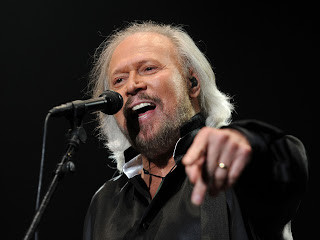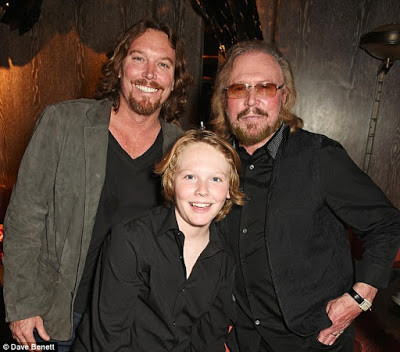The Bee Gees’ “You Should Be Dancing” is more than just a disco classic; it’s a testament to musical innovation and rhythmic exploration. Released in 1976, this electrifying track quickly climbed the charts, becoming a defining song of the disco era and cementing its place in music history. As we celebrate the song’s enduring legacy, we delve into a fascinating interview excerpt with Barry Gibb, offering a unique glimpse into the creation of this iconic hit and the story behind what makes “You Should Be Dancing” so special, even if the direct focus isn’t solely on “You Should Be Dancing Lyrics”.
The 40th Anniversary of a Number One Hit: More Than Just Lyrics
In a recent interview, Tim Roxborogh spoke with Barry Gibb about his new album In The Now, which led to a nostalgic look back at the Bee Gees’ illustrious career. One highlight of their conversation was the 40th anniversary of “You Should Be Dancing” reaching number one in the US charts. This milestone prompted a discussion about the song’s intricate recording process and the vibrant stories behind its creation.
Barry Gibb reminisced about the meticulous work that went into crafting “You Should Be Dancing.” Far from being a straightforward recording, the track was cut at least four times over a demanding two-week period. The Bee Gees were relentless in their pursuit of sonic perfection, constantly refining and layering elements to achieve the song’s distinctive sound. This dedication to detail is evident even when you consider the “you should be dancing lyrics” in the context of the overall production.
Stephen Stills and the Rhythmic Magic: Beyond Just the “You Should Be Dancing” Lyrics
Gibb shared an intriguing anecdote about Stephen Stills, the legendary musician known for his work with Crosby, Stills & Nash. Stills contributed to the song’s rich percussion, adding layers of rhythm at the unusual hour of 5 in the morning. This collaboration highlights the experimental and collaborative spirit that permeated the recording sessions. The Bee Gees were actively exploring new sonic territories, particularly Latin rhythms, influenced by their Miami surroundings. This rhythmic exploration is a key element that elevates “You Should Be Dancing” beyond just its memorable “you should be dancing lyrics.”
 Barry Gibb
Barry Gibb
Unveiling Hidden Vocal Layers and Falsetto Secrets
Roxborogh expressed his admiration for the song’s complexity, noting how repeated listens reveal new layers of detail. He mentioned his recent discovery of Barry Gibb’s falsetto harmony woven into the trumpet solo. This hidden vocal layer, often missed in the full mix, showcases the Gibb brothers’ exceptional vocal arrangements and Barry’s impressive falsetto technique, a signature element that complements the “you should be dancing lyrics”.
Gibb confirmed this intricate vocal layering, explaining that adding unexpected elements was a hallmark of their recording process during that era. With the advent of multi-track recording, they embraced the freedom to experiment and enrich their songs with unusual sonic textures. He cited his vocal explosion effect on “Tragedy” as another example of this innovative approach, demonstrating how they went beyond traditional instrumentation to create unique sounds, enhancing the impact of songs even beyond their lyrical content, like “you should be dancing lyrics”.
The Collaborative Mix: A Ten-Person Balancing Act
The mixing process for “You Should Be Dancing” was as intricate as its recording. Gibb revealed that it took ten people at the mixing board to balance the multitude of tracks in a live mix. In the pre-digital era, mixing was a high-stakes performance, requiring precise coordination and real-time adjustments. Barry Gibb’s specific role was controlling the echo repeat on the line “Whatcha’ doin’ on ya’ back?”, a subtle but crucial detail that added to the song’s dynamic texture and rhythmic feel, working in harmony with the “you should be dancing lyrics”.
This anecdote underscores the dedication and collaborative effort required to achieve the polished and dynamic sound of “You Should Be Dancing.” The Bee Gees and their production team were pioneers, pushing the boundaries of studio technology and creative collaboration to craft a truly groundbreaking disco anthem.
 Ashley, Lucas and Barry Gibb.
Ashley, Lucas and Barry Gibb.
From Inspiration to Icon: The Genesis of a Dance Floor Filler
Reflecting on the song’s potential for success, Gibb admitted that while predicting a hit is never certain, they knew “You Should Be Dancing” was special. Inspired by the burgeoning dance scene, the Bee Gees set out to create a song that would make everyone want to move. This intention, combined with their musical genius and innovative production techniques, resulted in a song that transcended trends and continues to resonate with audiences today. While the interview doesn’t explicitly dissect “you should be dancing lyrics”, it reveals the broader context and musical craftsmanship that made the song a global phenomenon.
Gibb likened their approach to Paul McCartney’s admiration for The Beach Boys, aiming to create something inspired by artists they admired. “You Should Be Dancing” embodies this spirit of inspiration and innovation, becoming a unique creation that stands alongside other Bee Gees classics like “How Deep Is Your Love” and “Jive Talkin’.”
Experience the Vocals: A New Way to Appreciate a Classic
For those wanting to truly appreciate the vocal intricacies of “You Should Be Dancing”, the original article suggests listening to a vocals-only version available on YouTube. This stripped-down version allows listeners to fully appreciate the Gibb brothers’ harmonies, Barry’s falsetto, and the subtle vocal details that are often buried in the full instrumental mix. It’s a fantastic way to rediscover the magic of “You Should Be Dancing” and gain a deeper understanding of its musical genius, even beyond the catchy “you should be dancing lyrics”.
In The Now and Beyond: Barry Gibb’s Enduring Musical Journey
While this interview segment focuses on the history of “You Should Be Dancing,” it’s also a reminder of Barry Gibb’s enduring musical journey. From disco anthems to heartfelt ballads, his contributions to music are undeniable. And as he continues to create new music with albums like In The Now, his legacy as a musical innovator and icon is firmly cemented. Explore Barry Gibb’s new music and revisit the classics like “You Should Be Dancing” to appreciate the full spectrum of his remarkable career and the timeless appeal of songs that go beyond just the “you should be dancing lyrics”.


